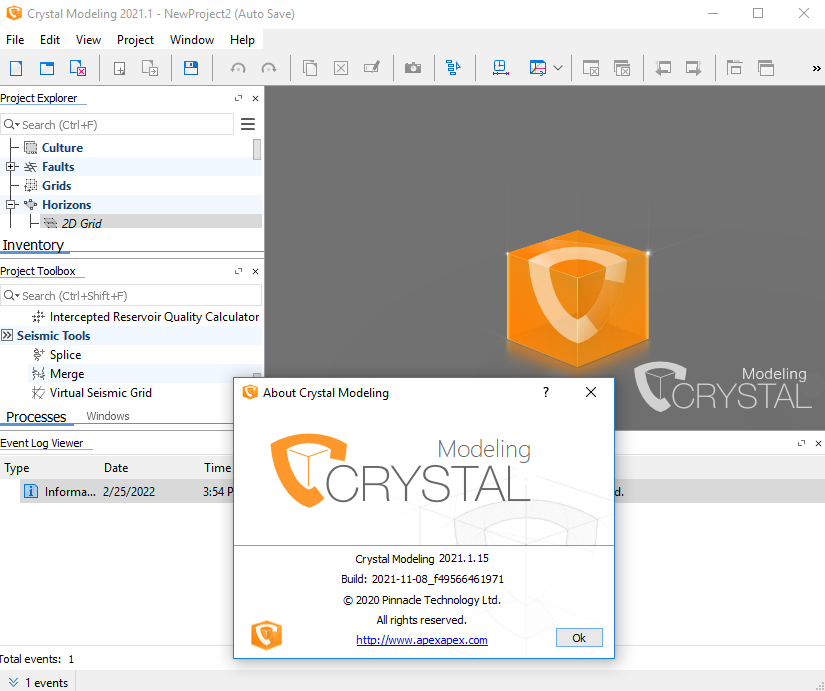نرم افزار جامع سایزمیک | Crystal Modeling 2021.1

CRYSTAL is a reservoir prediction and property modeling platform developed by SIGMA3, running on Windows system. CRYSTAL can be used in early, middle and developmental stages of exploration. At the stage, through seismic attribute analysis, reservoir inversion and attribute modeling, it helps geological and geophysical researchers to accurately predict reservoirs, describe reservoir properties (such as porosity, permeability, etc.), design and optimize reservoir development plans. The prediction results can be directly used for well site plan design and reservoir numerical simulation. Its main functions include: 3D geological framework modeling, seismic. Attribute analysis, reservoir inversion, geological attribute modeling, and fracture modeling.
1. Data management
CRYSTAL software can load data in various mainstream formats (such as SEG-Y, interpretation horizon data, layered data, logging LAS format data, etc.).
CRYSTAL uses TGS fast graphics engine and LDM technology to complete 3D visualization of large data volumes, including 3D seismic and Visual display of geological models. It also has the functions of fast 2D display, plan view and logging display editing.
CRYSTAL contains a set of seismic and logging data preprocessing modules, including coherent attribute calculation, curvature attribute calculation model Piece.
CRYSTAL can also be connected to most commercial interpretation software and numerical simulation software platforms.
2. Construction of 3D geological framework model
CRYSTAL can establish 3D geological frame model and geological grid model based on single-value or multi-value horizon data and fault data. It is especially suitable for structural modeling of complex building blocks. CRYSTAL provides a concise, fast and robust interactive structural modeling method, even in complex structural areas, users can it can quickly create and edit horizons and faults in two ways, automatically or interactively, and accurately handle the intersection between horizons and faults system, set the stratigraphic deposition contact type.
Mesh coarsening is possible, and its 3D mesh can be exported to Eclipse and CMG for numerical simulation, or to Petrel Wait for the software to perform other processing.
3. Synthetic recording and wavelet extraction
CRYSTAL provides flexible synthetic record production tools, which can complete vertical well, inclined well synthetic record comparison and well seismic calibration.
In order to improve the rationality and accuracy of the comparison of synthetic records, a time-frequency analysis tool is provided to assist the well-seismic calibration.
For deviated well calibration, CRYSTAL uses patented technology to carry out deviated well synthetic recording and wavelet extraction: walking along the deviated well trajectory the dip angle is superimposed on the corridor to form a seismic trace next to the well, and then the seismic wavelets are obtained to ensure the accuracy and reliability of the subsequent seismic inversion.
4. Time-depth conversion
CRYSTAL provides accurate time-depth conversion tools. Through the constraints of the time-depth relationship of the framework model, the use of logging data, interpretation Horizons, etc., use autoregression and other methods to establish a velocity model, and then perform time-depth conversion of the three-dimensional data volume to establish an accurate depth model. Degree domain model.
5. Seismic attribute analysis
CRYSTAL uses continuous wavelet transform for frequency division processing and seismic attribute analysis, including wavelet frequency division and attribute extraction. CRYSTAL extracts a variety of seismic properties, including instantaneous amplitude envelope, frequency and phase, on each crossover volume. Attribute comprehensive analysis research work.
6. SpecMAN time-frequency analysis
SpecMAN is a patented seismic spectral decomposition, AVO and seismic attribute analysis package. Its characteristics are as follows:
1) Support logging data and pre-stack data;
2) Spectral decomposition adopts most industry standard algorithms;
3) Contains a toolkit for analyzing four-dimensional spectral property volumes;
4) Patented ExSpect spectrum decomposition algorithm, based on matching pursuit algorithm.
Using SpecMAN can perform time-frequency analysis, focus on the target reservoir, and determine its spectral characteristics. SpecMAN also mentions
Provides 7 kinds of spectral attribute calculation and a variety of attribute analysis tools.
7. Deterministic inversion
CRYSTAL's patented technology. Deterministic inversion takes into account the influence of noise on the inversion process, and is an inversion algorithm based on earthquakes.
It can obtain inversion results that are faithful to the seismic data in the case of fewer wells, and has a lateral resolution comparable to the seismic data in the lateral direction. Through logging constraints, inversion results with higher vertical resolution can be obtained.
CRYSTAL also includes seismic-based inversion algorithms such as sparse pulse inversion, generalized linear inversion, and colored inversion. That, generalized linear inversion is a model-based inversion algorithm.
8. ThinMAN spectral inversion
ThinMAN is a high-resolution spectral inversion algorithm that reservoir researchers can use for "time-space adaptation" The spectral inversion, combined with the space-variable wavelet, uses the optimization algorithm to obtain high-resolution reflection coefficient volume and relative impedance imaging. ThinMAN can solve thin layer prediction problems smaller than the tuning thickness, and its focus is to obtain local Spectrum information. The output is a series of reflection coefficients, etc., and the apparent resolution is much higher than the input seismic data, which can be used to refine thin reservoirs.
Detailed description and characterization. main application:
1) Auxiliary seismic interpretation of reflectance volume;
2) Calculate the relative impedance volume from the reflection coefficient volume to assist seismic interpretation;
3) Seismic data volume is obtained by convolution of seismic wavelet with high cutoff frequency, which is used for seismic attribute analysis and inversion.
9. Multi-attribute inversion
Comprehensive analysis of multiple seismic attributes related to logging information to determine the best multiple seismic attributes related to reservoir physical properties. On this basis, the neural network technology is used to train under the control of the prior samples beside the well, and the continuous model of the attribute inversion is obtained. Type, and then carry out data volume inversion work.
CRYSTAL uses the above methods to invert various reservoir lithology and physical parameters such as porosity and shale content. Impedance cannot The environment of the reservoir and surrounding rock is well differentiated, and the multi-attribute approach can provide information beyond impedance. Multi-attribute inversion is nonlinear High-resolution inversion, especially for fluvial facies reservoirs (fast facies transition) and low signal-to-noise ratio areas.
10. Post-stack random inversion
Stochastic inversion is an effective high-resolution reservoir prediction tool when drilling data is abundant in the work area. Based on known reservoir data as Based on the theory of random functions, multiple optional, equal-probability reservoir models are generated, through synthetic records and actual seismic Compare the channels to determine the reasonable impedance. CRYSTAL determines the variation ellipsoid of spatial variables in the horizontal and vertical directions through seismic attributes, logging information, etc. Describe the spatial variation of reservoir lithology and physical properties.
The stochastic inversion method can make full use of abundant logging information in the middle and late stages of exploration and development. The angle reflects the uncertainty of reservoir lithology and physical properties.
11. Prestack inversion
CRYSTAL includes two prestack inversion algorithms: prestack extended elastic impedance and prestack stochastic inversion.
1) Pre-stack Extended Elastic Impedance (EEI) inversion: Using the extended elastic impedance formula, using the pre-stack partial superposition data, Perform the inversion of longitudinal and shear wave velocity and density. The inversion process is based on seismic data and combined with logging data to obtain various elastic models. The resolution of the inversion results is comparable to that of seismic data. According to the inversion results of compression and shear wave impedance and other inversion results, lithology, content Oil and gas analysis to predict the distribution law of oil and gas reservoirs.
2) Pre-stack stochastic inversion module: CRYSTAL uses stochastic simulation algorithm combined with global algorithms such as simulated annealing to perform different parts Simultaneous inversion of superimposed data volumes. CRYSTAL optimizes the stochastic simulation algorithm, which improves the operation efficiency and makes the algorithm stable enhancement. The various moduli obtained by pre-stack stochastic inversion have the same order of vertical resolution as well logging.
Under the premise of the calculation law, the uncertainty of the reservoir itself is described to the maximum extent, which is of great help for the identification of thin interbeds. Various moduli obtained by pre-stack inversion, such as the ratio of P-to-shear wave velocity, can well assist in the identification of lithology and fluids.
12. Geological attribute modeling
The CRYSTAL attribute modeling algorithm includes stochastic simulation and neural network, etc., can use attribute data volume, conventional inversion results, etc. as a soft constraint for the simulation.
It can realize functions such as deterministic modeling, stochastic modeling and phase-controlled modeling. The generated various reservoir geological models can be directly input To VIP, Eclipse and other reservoir numerical simulation software.
13. Fracture modeling
CRYSTAL uses continuous fracture modeling CFM technology for fracture modeling. The core algorithm of CFM is a neural network. Successful fracture modeling requires two factors: the fracture index obtained from the Indicating factors and controlling elements of fractures, such as seismic attributes, lithology, porosity, and structural information, etc. CFM can benefit Four types of data were used for fracture modeling.
1) High-resolution seismic attributes: obtained from pre-stack or post-stack data, including fractures and other fracture-related geological information. CRYSTAL includes a variety of calculation methods for seismic attribute bodies related to fractures, such as curvature calculation, similarity calculation, etc.
2) Geological properties: such as lithology, particle size, mineral composition, lithofacies, porosity and pore pressure, etc. fracture-related properties.
3) Geological geometry attributes: obtained by geological geometry modeling software, providing the formation force of the present or a certain period before condition.
4) Structural information: Provide information such as fault, structural plane, thickness, structural curvature, and distance to the fault.
CRYSTAL is able to generate discrete fracture (DFN) models using the CFM continuous mesh model.
14. Reservoir detection
CRYSTAL includes microseismic interpretation capabilities that combine hydraulic fracturing data and geological models to enable real-time decision making.
Reservoir engineers predict the location of microseismic occurrences on this platform, and determine the relative value of microseismic to horizons, faults, and well trajectories.
and the positional relationship of the fracture model defined on the geological grid. Hydraulic fracturing data (pressure data and other time-varying data) can be
تیم PetroTools آخرین نسخه این نرم افزار را برای شما ارائه می دهد. جهت تهیه نرم افزار با استفاده از منوی خرید با ما در تماس باشید
For buy software, Please contact us via buy menu



 O-Sense
O-Sense
